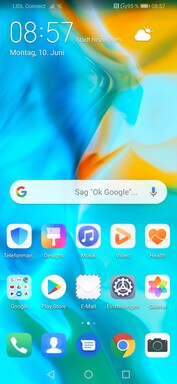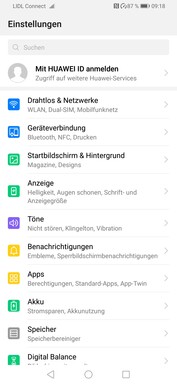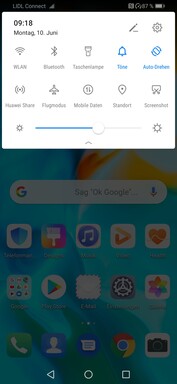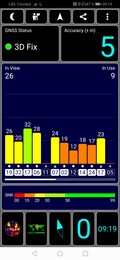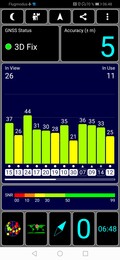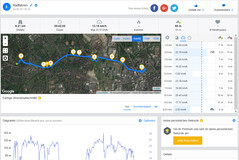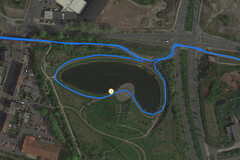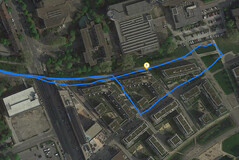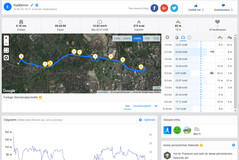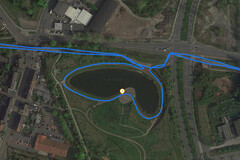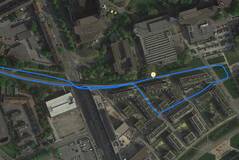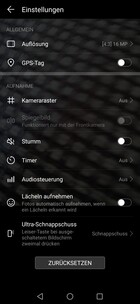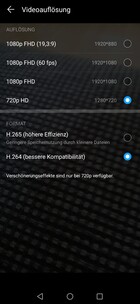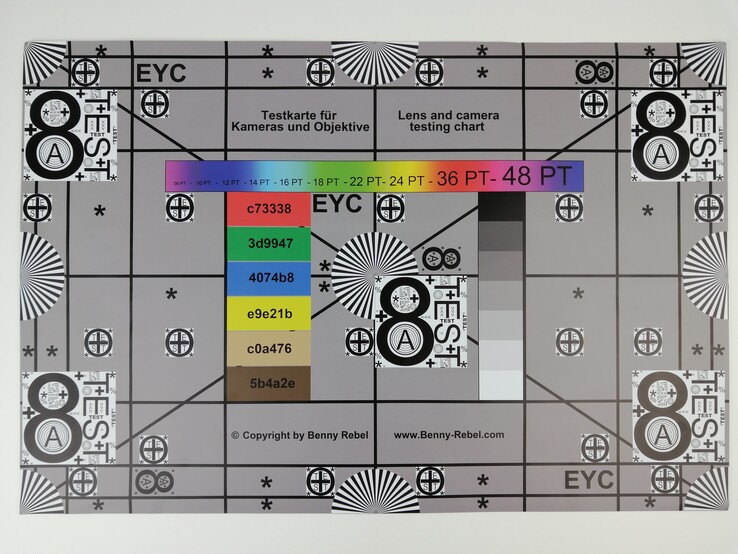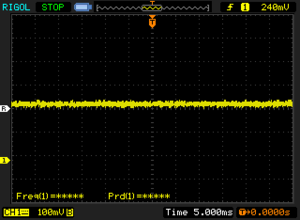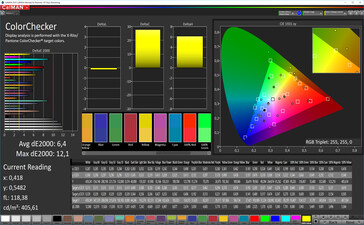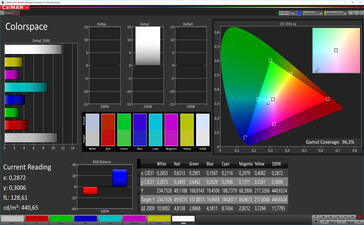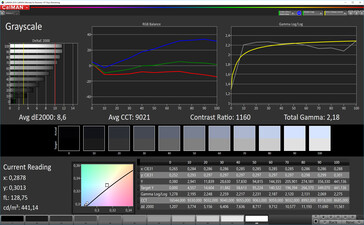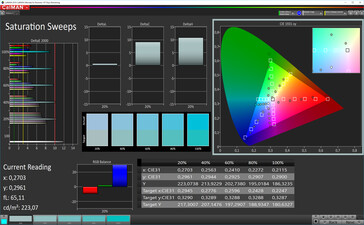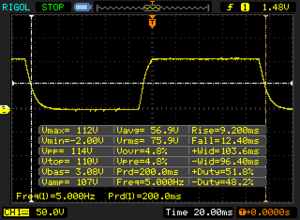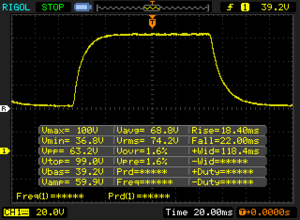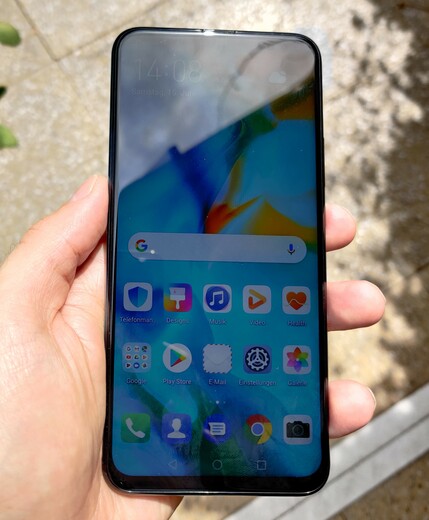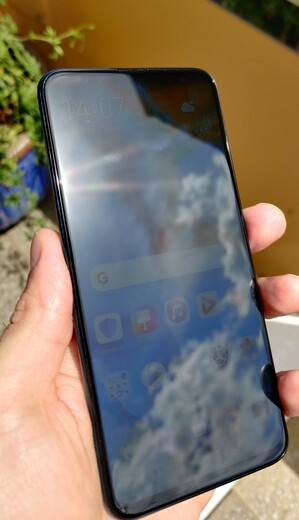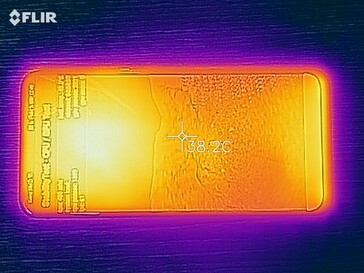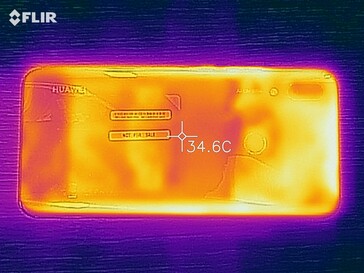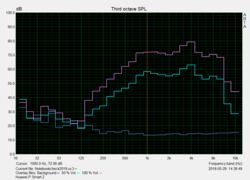Huawei P Smart Z Review: Mid-range smartphone with a pop-up camera

The first bezel-less smartphone from Huawei without a notch or punch hole does not come from the Mate or the high-priced P series of the Chinese manufacturer, but appears in the form of a mid-range smartphone, the P Smart Z. This is made possible by a pop-up camera module on the top edge of the Huawei smartphone.
The pop-up camera has a 16 Megapixel sensor and according to the manufacturer is supposed to withstand more than 100,000 motorized pop-up movements and up to 12 kg (~26 lb) of weight. On the back, Huawei has also placed a 16 Megapixel camera that is supported by a 2 Megapixel Bokeh lens. The front of the Huawei smartphone is dominated by a 6.59-inch IPS panel that has a resolution of 2340x1080 pixels. The in-house Kirin 710F SoC that is used is accompanied by 4 GB of RAM.
With German online vendors, the current street price of the Huawei P Smart Z ranges between 250 and 270 Euros (~$281-303). This places the mid-range smartphone in a very hotly contested price segment and the number of alternatives is accordingly large. As possible competitors and comparison devices, we chose the Samsung Galaxy A50, the Motorola Moto G7 Plus, the Sony Xperia 10, the Huawei P30 Lite, and the Xiaomi Mi 9 SE.
Case - The Huawei P Smart Z with a pop-up camera
The pop-up camera allows the Huawei P Smart Z to manage without a notch or punch hole in the display. Similar to the OnePlus 7 Pro, the case of the Huawei smartphone turns out relatively large due to the pop-up camera module. At 163.5 x 77.3 mm (6.44 x 3.04 in), the P Smart Z can hardly be operated with one hand. At more than 84%, the front of the P Smart Z consists almost entirely of the display and has one of the most efficient display-to-surface ratio in the mid-range price segment - but it still does not achieve the 91% specified by Huawei.
The slightly rounded back is made of plastic and available in three color variations: black (Midnight Black), green (Emerald Green), or blue (Starlight Blue). The plastic feels a bit cheap in the hands. This impression is reinforced by the plastic frame and also the slightly hollow back of the Huawei P Smart Z, which can be pressed down with just a little force. The motorized camera module also gives a wobbly impression, so that the case quality of the P Smart Z shows some weaknesses.
Despite the size of the phone, the keys for the volume control and On/Off button can still be easily reached, sit tightly in the frame, and have a comfortable pressure point. The Huawei smartphone lacks IP certification, allowing water and dust to get into the case.
Equipment - Huawei smartphone with a 3.5 mm audio port
The equipment of the mid-range smartphone includes a 3.5-mm headphone jack and a fingerprint sensor. There is no face-unlock function, nor a status LED, and also no Always-On display setting. In terms of the storage selection, buyers of the Huawei smartphone have to be content with 64 GB of eMMC storage, since the Chinese manufacturer does not offer a larger storage variant. After first use, 52 GB are still available to the user. On the other hand, the P Smart Z storage can be expanded up to 512 GB via microSD card. The exFAT file system is supported.
Wireless transfer of display contents to an external monitor via Miracast is also supported and worked without any problems in a test using a Sony Android TV. While the USB port is Type-C, it is internally connected via USB 2.0 and can charge the smartphone. In addition, it supports USB OTG, so that external storage media or input devices are recognized.
Software - The P Smart Z has Android 9 and EMUI 9.0
As the operating system, the Chinese manufacturer has installed Android version 9.0 and added its own in-house EMUI user interface on top. At the time of the test, the security patches are at the level of March 2019, so they are not quite current anymore.
The user interface of version 9.0 from the Chinese manufacturer appears strongly modified compared to stock Android. On the other hand, users of the Huawei P Smart Z can be pleased about a lot of additional setting options allowing them to personalize the phone. At the state of delivery, the software of the Huawei smartphone already supports Widevine DRM Level 1, allowing streaming of video contents from Netflix, Amazon Prime Video, and other content providers in HD quality.
Communication and GPS - The Huawei P Smart Z with NFC
Thanks to the IEEE-802.11 a/b/g/n/ac standards, the integrated WLAN module of the P Smart Z communicates in both the 2.4 GHz and 5 GHz frequency ranges. At 191 and 212 Mbps respectively, the transfer speeds between the Huawei smartphone and our Linksys EA 8500 reference router remain slightly below the level of other mid-range smartphones in the price range of around 300 Euros (~$337). In close proximity to the router (Telekom Speedport, W921V), the damping is low at barely -31 dBm.
The dual-SIM smartphone is able to access the mobile Internet with up to two nanoSIM cards at LTE speeds. The fast standard can be used with both SIM card slots. As is customary for a smartphone in this price class, the amount of frequency bands that are supported by the P Smart Z is limited, and the mid-range smartphone can only access 8 LTE bands. However, for using it locally (in Germany), you will not lack any frequency bands, except for LTE Band 28.
For wireless communication with peripheral devices, an NFC chip can be used, and the Huawei smartphone also supports Bluetooth version 4.2.
The Huawei P Smart Z determines its location via the GPS, GLONASS, and BeiDou satellite systems. Outdoors as well as indoors, the satellite fix succeeds after a short delay of less than one minute with an accuracy of about 5 meters (~16 ft).
In order to evaluate the locating accuracy of our test unit in practice, we record a bike route in parallel with the Garmin Edge 500 GPS bike computer and our smartphone. The deviations of the GPS module in our mid-range smartphone are very low, and at the end of our 9 km (~5.6 miles) test route, the difference between the recorded routes of the P Smart Z and the professional navigation device is only about 30 meters (~98 ft).
Telephone Functions and Voice Quality - Huawei smartphone with WLAN calling
Cameras - The Huawei P Smart Z with dual cameras
The highlight of the P Smart Z is the motorized 16-MP camera above the front, but this concerns only its design language. Despite the pop-up camera, the mid-range smartphone is not a selfie wizard. The recordings tend toward overexposure, are poor in detail, and show clear artifacts. We were also a bit disturbed by the blurriness of the photos. In addition, the aperture of f/2.0 is not very light sensitive.
The main camera in the back of the Huawei smartphone has two lenses with an aperture of f/1.8 and an autofocus with phase recognition. While the 16-MP main camera has a resolution of 4608x3456 pixels in the 4:3 format, the second camera sensor has a resolution of 2 MP. Thanks to the second lens, you can create Bokeh effects employing background blurriness.
The quality of the photos is not bad, at least not under good light conditions, particularly considering that the street price will probably soon level out at significantly below 250 Euros (~$281). In terms of the dynamic in the photos as well as the level of details, the recordings of the P Smart Z can only convince to a limited extent. The Sony IMX586 image sensor built into the Xiaomi Mi 9 SE offers a much more attractive photo quality. This is particularly the case under low light, where the P Smart Z shows too much image noise and too little sharpness.
The front camera can record videos in 1080p at up to 30 frames per second. The 16-MP camera on the back is also only able to record videos in Full HD resolution, but at least it is able to achieve up to 60 FPS.
Accessories and Warranty - P Smart Z with a headset and case
In addition to the smartphone itself, the box contains the quick-start instructions, a modular charger with a nominal power of 10 watts (5 V, 2 A), a USB charging cable, a protective display foil (which has already been installed), a silicone case, and headphones are also included.
Huawei offers a 24-month warranty period for smartphones.
Input Devices and Operation - A Huawei smartphone with a fast fingerprint sensor
The capacitive multi-touchscreen of the P Smart Z pleases in the test with its accurate and smooth operation. Input of up to 10 fingers simultaneously is supported. The anti-fingerprint glass surface feels comfortable and offers good sliding characteristics.
The active fingerprint sensor on the back is accurate and also fairly fast. However, after the biometric identification, there is some delay until the display is actually turned on. There is no face-unlock function via the pop-up front camera.
Display - The Huawei P Smart Z with a 6.59-inch IPS panel
The IPS-LC display measures 15.2 cm (6.59 in) in the diagonal. At a resolution of 2340x1080 pixels, this results in a pixel density of 391 PPI. During normal use and viewing distances, pixel structures are not visible. Subjectively, the display of text contents appears sharp, even with smaller type fonts.
The maximum brightness of 439 cd/m² that we measured is slightly low for a mid-range smartphone, particularly considering that with the activated brightness sensor to control the display brightness, only 449 cd/m² are achieved. On the other hand, at 92% the brightness distribution is even.
The realistic APL50 Test (Average Picture Level) with evenly distributed bright and dark areas also achieves almost the same brightness of only 427 cd/m².
| |||||||||||||||||||||||||
Brightness Distribution: 92 %
Center on Battery: 439 cd/m²
Contrast: 1219:1 (Black: 0.36 cd/m²)
ΔE ColorChecker Calman: 6.4 | ∀{0.5-29.43 Ø4.78}
ΔE Greyscale Calman: 8.6 | ∀{0.09-98 Ø5}
96.3% sRGB (Calman 2D)
Gamma: 2.18
CCT: 9021 K
| Huawei P Smart Z 2019 LCD IPS, 2340x1080, 6.6" | Xiaomi Mi 9 SE AMOLED, 2340x1080, 6" | Huawei P30 Lite IPS LCD, 2312x1080, 6.2" | Motorola Moto G7 Plus IPS, 2270x1080, 6.2" | Sony Xperia 10 IPS-LCD, 2520x1080, 6" | Samsung Galaxy A50 AMOLED, 2340x1080, 6.4" | |
|---|---|---|---|---|---|---|
| Screen | 47% | 16% | -2% | 20% | 41% | |
| Brightness middle (cd/m²) | 439 | 583 33% | 451 3% | 537 22% | 547 25% | 644 47% |
| Brightness (cd/m²) | 431 | 577 34% | 430 0% | 525 22% | 525 22% | 628 46% |
| Brightness Distribution (%) | 92 | 97 5% | 90 -2% | 85 -8% | 93 1% | 91 -1% |
| Black Level * (cd/m²) | 0.36 | 0.55 -53% | 0.58 -61% | 0.36 -0% | ||
| Contrast (:1) | 1219 | 820 -33% | 926 -24% | 1519 25% | ||
| Colorchecker dE 2000 * | 6.4 | 1.6 75% | 1.4 78% | 6.41 -0% | 4.6 28% | 2.64 59% |
| Colorchecker dE 2000 max. * | 12.1 | 3.9 68% | 4.4 64% | 10.86 10% | 12.1 -0% | 9.23 24% |
| Greyscale dE 2000 * | 8.6 | 2.7 69% | 2.5 71% | 6.7 22% | 3.9 55% | 2.5 71% |
| Gamma | 2.18 101% | 2.27 97% | 2.22 99% | 2.099 105% | 2.17 101% | 2.024 109% |
| CCT | 9021 72% | 6267 104% | 6422 101% | 8310 78% | 7158 91% | 6649 98% |
* ... smaller is better
Screen Flickering / PWM (Pulse-Width Modulation)
| Screen flickering / PWM not detected | |||
In comparison: 53 % of all tested devices do not use PWM to dim the display. If PWM was detected, an average of 8111 (minimum: 5 - maximum: 343500) Hz was measured. | |||
The combination of the low display brightness with a black value of 0.36 cd/m², which is still considered good for an IPS panel, results in a satisfactory contrast ratio of 1219:1. In the realistic measurement of the display brightness with evenly distributed bright and dark areas (APL50 Test), we determine a black value of 0.37 cd/m², so that the contrast ratio is slightly reduced (1157:1).
Using the X-Rite photo spectrometer (i1pro 2) and the CalMAN analysis software, we evaluate the color reproduction of the P Smart Z display. The sRGB color space is to a large extent covered by the IPS panel. At 8.6 and 6.4 respectively, the average DeltaE deviation in the grayscale and the mixed colors is clearly above the ideal target range below 3. The ideal color temperature of 6500 K is also clearly exceeded by the Huawei smartphone, and the grayscale shows a visible blue tint in bright areas.
Display Response Times
| ↔ Response Time Black to White | ||
|---|---|---|
| 21.6 ms ... rise ↗ and fall ↘ combined | ↗ 9.2 ms rise | |
| ↘ 12.4 ms fall | ||
| The screen shows good response rates in our tests, but may be too slow for competitive gamers. In comparison, all tested devices range from 0.1 (minimum) to 240 (maximum) ms. » 46 % of all devices are better. This means that the measured response time is similar to the average of all tested devices (20.2 ms). | ||
| ↔ Response Time 50% Grey to 80% Grey | ||
| 40.4 ms ... rise ↗ and fall ↘ combined | ↗ 18.4 ms rise | |
| ↘ 22 ms fall | ||
| The screen shows slow response rates in our tests and will be unsatisfactory for gamers. In comparison, all tested devices range from 0.165 (minimum) to 636 (maximum) ms. » 63 % of all devices are better. This means that the measured response time is worse than the average of all tested devices (31.6 ms). | ||
The viewing angle stability of the built-in liquid crystal display is able to convince, and the reduction in brightness when looking from an angle is also low. When using it outdoors, due to its low brightness, the IPS panel does not strike a good figure with its pronounced reflections – at least under the currently prevalent summery conditions with bright sunlight.
Performance - The Huawei P Smart Z with a HiSilicon Kirin 710F
Like its sibling model, the HiSilicon Kirin 710F built into the Huawei P Smart Z has four ARM Cortex A73 processor cores with a speed of up to 2.2 GHz and four Cortex A53 cores with up to 1.7 GHz in the big.LITTLE combination. However, its production process is slightly different. The "F" in the model designation stands for FCCSP (Flip Chip Chip Scale Package).
Similar to the Kirin 980, the mid-range SoC offers GPU Turbo support as well as an integrated Neuronal Processing Unit (NPU), which handles the AI functions. The integrated graphics card is an ARM Mali-G51 MP4. This mid-range GPU is based on the Bifrost architecture and uses four of the possible twelve cores in the MP4 variant. The graphics APIs support the Mali-G51 graphics standards such as OpenGL ES 3.2, Vulkan 1.0, OpenCL 2.0, DirectX 11, and Renderscript.
In the benchmarks, the Kirin 710F in combination with 4 GB of RAM meets the other Android competitors in our test to a large extent at eye level. However, in the processor as well as the graphics intensive benchmarks, the results of the P Smart Z remain below the Snapdragon 710 of the Xiaomi Mi 9 SE.
In everyday operation, the system performance of the P Smart Z is also satisfactory. The navigation using the Android user interface works mostly smoothly. During multi-tasking, some delays occur and the load times are noticeably longer. As before in the P30 Lite, the Huawei mid-range processor does not always appear to handle the daily tasks masterfully.
| AnTuTu v7 - Total Score (sort by value) | |
| Huawei P Smart Z 2019 | |
| Xiaomi Mi 9 SE | |
| Huawei P30 Lite | |
| Motorola Moto G7 Plus | |
| Sony Xperia 10 | |
| Samsung Galaxy A50 | |
| Average HiSilicon Kirin 710 (124870 - 183420, n=10) | |
While surfing with the Chrome browser, you don't have to worry about a lack of speed. For a mid-range smartphone, the P Smart Z does a completely acceptable job in all the benchmarks. In practice, even demanding web sites can be loaded relatively fast and without errors.
| Jetstream 2 - 2.0 Total Score | |
| Average of class Smartphone (23.8 - 387, n=153, last 2 years) | |
| Xiaomi Mi 9 SE (Chrome 73) | |
| Huawei P Smart Z 2019 (Chrome 74) | |
| Huawei P30 Lite (Chrome 74) | |
| Average HiSilicon Kirin 710 (30 - 33, n=8) | |
| Sony Xperia 10 (Chrome Version 73) | |
| Octane V2 - Total Score | |
| Average of class Smartphone (2228 - 121337, n=201, last 2 years) | |
| Xiaomi Mi 9 SE (Chrome 73) | |
| Samsung Galaxy A50 (Chrome 73) | |
| Huawei P Smart Z 2019 (Chrome 74) | |
| Huawei P30 Lite (Chrome 74) | |
| Average HiSilicon Kirin 710 (9041 - 10544, n=13) | |
| Motorola Moto G7 Plus | |
| Sony Xperia 10 (Chrome Version 73) | |
| Mozilla Kraken 1.1 - Total | |
| Sony Xperia 10 (Chrome Version 73) | |
| Motorola Moto G7 Plus | |
| Average HiSilicon Kirin 710 (3999 - 4853, n=13) | |
| Huawei P30 Lite (Chrome 74) | |
| Huawei P Smart Z 2019 (Chrome 74) | |
| Samsung Galaxy A50 (Chrome 73) | |
| Xiaomi Mi 9 SE (Chrome 73) | |
| Average of class Smartphone (257 - 28190, n=156, last 2 years) | |
* ... smaller is better
The measured speeds while reading from and writing to the internal storage are not very high, but on a very good level for eMMC storage. The access rates of the microSD card slot, which we tested with our Toshiba Exceria Pro M501 (max. 270 Mbps reading and max. 150 Mbps writing), are very satisfactory in the Huawei smartphone, compared to the competitors.
| Huawei P Smart Z 2019 | Xiaomi Mi 9 SE | Huawei P30 Lite | Motorola Moto G7 Plus | Sony Xperia 10 | Samsung Galaxy A50 | Average 64 GB eMMC Flash | Average of class Smartphone | |
|---|---|---|---|---|---|---|---|---|
| AndroBench 3-5 | 3% | -5% | -4% | -19% | -3% | -20% | 510% | |
| Sequential Read 256KB (MB/s) | 304.3 | 492.5 62% | 293.2 -4% | 283.6 -7% | 273.8 -10% | 507 67% | 277 ? -9% | 2226 ? 632% |
| Sequential Write 256KB (MB/s) | 191.8 | 190.1 -1% | 158.6 -17% | 208.7 9% | 232.9 21% | 192.1 0% | 178.4 ? -7% | 1848 ? 864% |
| Random Read 4KB (MB/s) | 94.1 | 115.8 23% | 71.6 -24% | 76.6 -19% | 53.1 -44% | 98.9 5% | 60.7 ? -35% | 295 ? 213% |
| Random Write 4KB (MB/s) | 78 | 21.86 -72% | 87.3 12% | 73.1 -6% | 14.39 -82% | 18.2 -77% | 33.8 ? -57% | 335 ? 329% |
| Sequential Read 256KB SDCard (MB/s) | 76.4 ? | 76.8 ? 1% | 82.8 ? 8% | 83.2 ? 9% | 73.9 ? -3% | 77.4 ? 1% | ||
| Sequential Write 256KB SDCard (MB/s) | 67.5 ? | 67.8 ? 0% | 62.1 ? -8% | 63.8 ? -5% | 60.7 ? -10% | 58.3 ? -14% |
Games - The P Smart Z with a Mali G51 MP4
While the built-in ARM Mali-G51 MP4 is not particularly powerful, it still allows to display more demanding 3D games without stutters. Demanding Android games from the Play Store run relatively smoothly at the lowest graphics setting using the GPU.
The control via touchscreen as well as the position sensor responds quickly and accurately in our test.
Emissions - A hot Huawei smartphone
Temperature
The front of the Huawei smartphone warms up considerably under load. While the temperatures under load conditions are not impacting everyday usage, they are clearly noticeable.
(±) The maximum temperature on the upper side is 42.9 °C / 109 F, compared to the average of 35.2 °C / 95 F, ranging from 21.9 to 247 °C for the class Smartphone.
(±) The bottom heats up to a maximum of 41.3 °C / 106 F, compared to the average of 34 °C / 93 F
(±) In idle usage, the average temperature for the upper side is 35.2 °C / 95 F, compared to the device average of 32.9 °C / 91 F.
Speaker
The maximum volume of the mono speaker on the bottom edge is sufficiently loud at 85 dB(A). However, the offered sound quality is only mediocre. In our Pink Noise measurement, the diagram shows a reproduction of mids and highs that is not very linear. As expected, the bass range in particular is lacking.
Besides the mono speaker, the audio can also be output via Bluetooth 4.2 or the 3.5-mm audio port. In our subjective impression, music reproduction is sufficiently loud and lacks additional noises.
Huawei P Smart Z 2019 audio analysis
(+) | speakers can play relatively loud (85.1 dB)
Bass 100 - 315 Hz
(-) | nearly no bass - on average 30.4% lower than median
(±) | linearity of bass is average (10.9% delta to prev. frequency)
Mids 400 - 2000 Hz
(+) | balanced mids - only 4.6% away from median
(+) | mids are linear (5% delta to prev. frequency)
Highs 2 - 16 kHz
(+) | balanced highs - only 4.2% away from median
(+) | highs are linear (6.2% delta to prev. frequency)
Overall 100 - 16.000 Hz
(±) | linearity of overall sound is average (23.5% difference to median)
Compared to same class
» 53% of all tested devices in this class were better, 8% similar, 39% worse
» The best had a delta of 11%, average was 35%, worst was 134%
Compared to all devices tested
» 69% of all tested devices were better, 6% similar, 24% worse
» The best had a delta of 4%, average was 24%, worst was 134%
Xiaomi Mi 9 SE audio analysis
(±) | speaker loudness is average but good (81.5 dB)
Bass 100 - 315 Hz
(-) | nearly no bass - on average 21.9% lower than median
(±) | linearity of bass is average (12.8% delta to prev. frequency)
Mids 400 - 2000 Hz
(+) | balanced mids - only 2.5% away from median
(+) | mids are linear (4.5% delta to prev. frequency)
Highs 2 - 16 kHz
(+) | balanced highs - only 3.2% away from median
(+) | highs are linear (6.3% delta to prev. frequency)
Overall 100 - 16.000 Hz
(±) | linearity of overall sound is average (18.7% difference to median)
Compared to same class
» 21% of all tested devices in this class were better, 9% similar, 69% worse
» The best had a delta of 11%, average was 35%, worst was 134%
Compared to all devices tested
» 42% of all tested devices were better, 8% similar, 51% worse
» The best had a delta of 4%, average was 24%, worst was 134%
Battery Life - A Huawei smartphone with a large battery
Power Consumption
Overall, the consumption of the Huawei P Smart Z is okay for a smartphone with an almost 6.6-inch IPS panel, ranging at the same level as the P30 Lite, which has a significantly smaller display.
| Off / Standby | |
| Idle | |
| Load |
|
Key:
min: | |
| Huawei P Smart Z 2019 4000 mAh | Xiaomi Mi 9 SE 3070 mAh | Huawei P30 Lite 3340 mAh | Motorola Moto G7 Plus 3000 mAh | Sony Xperia 10 2870 mAh | Samsung Galaxy A50 4000 mAh | Average HiSilicon Kirin 710 | Average of class Smartphone | |
|---|---|---|---|---|---|---|---|---|
| Power Consumption | 42% | -2% | -0% | 18% | 7% | -5% | -6% | |
| Idle Minimum * (Watt) | 0.85 | 0.53 38% | 0.91 -7% | 1.1 -29% | 0.72 15% | 0.8 6% | 1.058 ? -24% | 0.848 ? -0% |
| Idle Average * (Watt) | 2.4 | 1.18 51% | 2.41 -0% | 1.7 29% | 2.16 10% | 1.5 37% | 2.2 ? 8% | 1.434 ? 40% |
| Idle Maximum * (Watt) | 2.43 | 1.2 51% | 2.43 -0% | 2.1 14% | 2.17 11% | 1.7 30% | 2.57 ? -6% | 1.618 ? 33% |
| Load Average * (Watt) | 4.62 | 3.04 34% | 4.57 1% | 5.1 -10% | 3.32 28% | 5.9 -28% | 4.61 ? -0% | 7.01 ? -52% |
| Load Maximum * (Watt) | 7.44 | 4.83 35% | 7.57 -2% | 7.9 -6% | 5.34 28% | 8.3 -12% | 7.6 ? -2% | 11.3 ? -52% |
* ... smaller is better
Battery Life
With about 12.5 hours, the 4000-mAh battery of the Huawei smartphone lasts for a very long time in our WLAN surf test at an adjusted brightness level.
| Huawei P Smart Z 2019 4000 mAh | Xiaomi Mi 9 SE 3070 mAh | Huawei P30 Lite 3340 mAh | Motorola Moto G7 Plus 3000 mAh | Sony Xperia 10 2870 mAh | Samsung Galaxy A50 4000 mAh | |
|---|---|---|---|---|---|---|
| Battery runtime | ||||||
| WiFi v1.3 (h) | 12.4 | 8.5 -31% | 8.6 -31% | 11.9 -4% | 9 -27% | 11.7 -6% |
Pros
Cons
Verdict - A mid-range phone for design fanatics
The Huawei P Smart Z stands out from the mid-range crowd, due to its bezel-less design that manages without a notch or punch hole. This is made possible by its pop-up camera module. However, besides the pop-up camera, the P Smart Z hardly offers any other advantages worth mentioning that help to differentiate the Huawei phone from the Android mid-range. Instead, due to its build, the buyer has to accept significant ergonomic disadvantages. In addition, we only like the quality of the workmanship of the P Smart Z to a limited extent.
The pop-up camera module makes the Huawei P Smart Z a real looker. Those who can live with the weaknesses that we have pointed out will get a solid mid-range smartphone with great visuals.
The display quality and the built-in camera modules also did not convince us. Although the front camera has been moved outside the display and should thus have more space available, the built-in lens equipment leaves a lot of room for improvement in terms of its quality.
Huawei P Smart Z 2019
- 06/17/2019 v6 (old)
Marcus Herbrich








